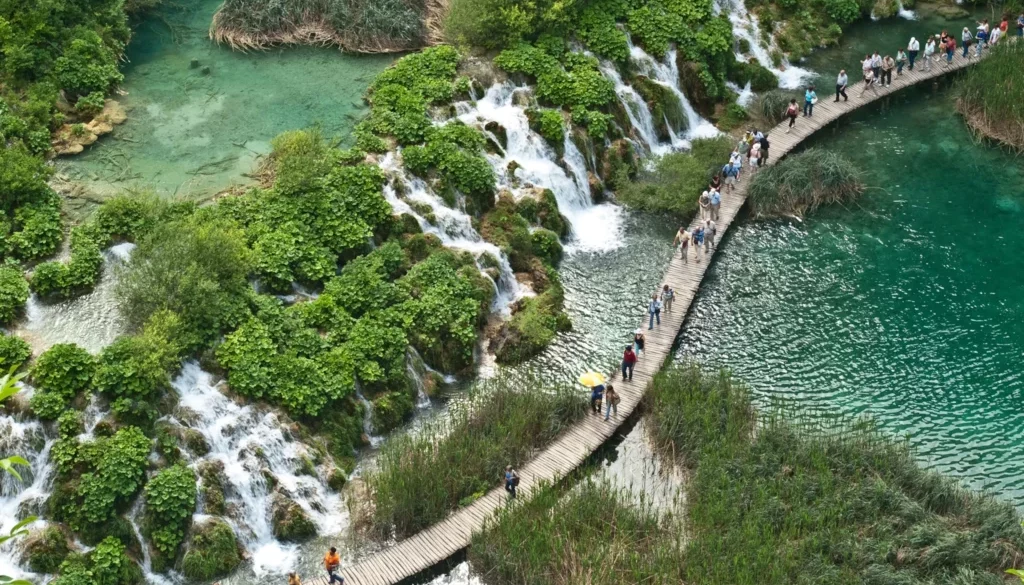Croatia
Croatia
Silvopastoral practices in Croatia
The term agroforestry in Croatia is still quite unknown. However, if we look at the traditional agricultural practices in the coastal area of Croatia, the Mediterranean part, we can see that keeping livestock in the open was a common practice. The same way in the continental part of Croatia, it was very common to feed pigs with acorns from grand oak forests in the eastern part of Croatia. These traditional practices are dying out. Today in the Mediterranean part of Croatia we can read about the damage in olive grows from sheep grazing which reflects negatively on farmers motivation to incorporate livestock grazing with other agricultural production such as orchards.
In the eastern part of Croatia, there is an initiative in supporting the breeding of Black Slavonian pig, a pig that is kept out in the open. It has more quality meat than commercial pigs. However, due to the cheap imported meat, the Black Slavonian pig is not getting the price that is needed to make it’s breading profitable.
These two issues are the main obstacles in blocking the silvopastoral practices in the Mediterranean and Continental Croatia. If we manage to control sheep grazing in olive grows and if the farmer can get the proper price for the meat of Black Slavonian pig, we could expect the development of silvopastoral practices in Croatia. For the time being agroforestry as a practice is still not fully recognized and these two separate issues from the Mediterranean and Continental part of Croatia are key obstacles in the development of silvopastoral systems in Croatia.
Alley cropping systems in Croatia
Eastern part of Croatia, often referred to as the breadbasket of Croatia (and previously of Yugoslavia), has been during centuries transformed from forest to agricultural land. Trees, including hedges, have been removed leaving a landscape of endless agricultural fields. Alley cropping systems are non-existent. Although, in the 60s the Institute of Forestry had quite successful trials of intercropping agricultural species into young poplar stands. These trials were initiated by the forestry department investigating a growing poplar production. The main purpose of intercropping in poplar stands at that time was growing food for wildlife in hunting areas. This was possible only in the first few years of poplar stands, after the fourth year the yields would start to decrease due to the shadow effect but also due to the lack of mineral fertilization (Bura, 1962).
Figure 1: Poplar and corn agroforestry system near Osijek (photo by: D. Bura)
Figure 2: Poplar and soy bean agroforestry system near Sremska Mitrovica (photo by: D. Bura)
Today such stands don’t exist anymore. However, there is a growing interest in practicing sustainable agriculture worldwide. In that context, in 2019 short rotation coppice has been incorporated into green payments (subsidies) in Croatia by regulation on SRC (Official Gazette 16/2019) which should make establishing alley cropping attractive to farmers. By law, each farmer that has more than 15 ha of land has to practice ecological and conservation agriculture on at least 5% of its land. Such practice can also include establishing SRC stands. This legislation has made the introduction of trees back to the agricultural land attractive again. So unlike the 60’s when the initiative of intercropping came from the forestry side, this time the initiative has been supported from the agricultural side.
Table 1: List of tree species approved for green payment on agricultural land (Source: Official Gazette NN 16/2019)
Alnus glutinosa (L.) Gaertn. |
Alnus incana (L.) Moench. |
Betula pendula Roth. |
Carpinus betulus L. |
Miscanthus x giganteus*/** |
Populus nigra L. Populus deltoides W. Bartram ex Marshall* Populus alba L. Populus deltoides x Populus nigra* |
Salix alba L. Salix alba x Salix fragilis, Salix matsudana Koidz.* Salix matsudana × (Salix matsudana × Salix alba)* |
Paulownia elongata* Paulownia elongata × Paulownia fortune BELLISSIA*, Paulownia elongata × Paulownia fortunei RBTC15*, Paulownia fortunei* Paulownia fortunei × Paulownia tomentosa 9501* Paulownia fortunei x Paulownia tomentosa SHAN TONG* |
* forgein species, ** sterile cultivars
Agroforestry research in Croatia
However, not many farmers are convinced of the profitability of such systems so very few of them are establishing SRC stands. On the Faculty of Agrobiotechnical Sciences in Osijek, two projects are investigating the possibility of intercropping wood species with agricultural crops. Project funded by Croatian Science Foundation (UIP-2017-05-7103 Intercropping of wood species and crops as an innovative approach in agroecosystems) is investigating the possibility of cropping in the walnut orchards (Figures 3, 4 and 5).
Figure 3: Buckwheat in walnut orchard (photo by: Vladimir Ivezić)
Figure 4: Wheat in the walnut orchard (photo by: Vladimir Ivezić)
Figure 5: Corn in the walnut orchard (photo by: Vladimir Ivezić)
Another project funded by the Faculty of Agrobiotechnical Sciences in Osijek investigates possibilities and advantages of establishing alley cropping systems with willow, poplar, and robinia in alley width of 24 m (Figures 6, 7 and 8).
Figure 6: Cropping systems with willow in alley width of 24 m (photo by: Vladimir Ivezić)
Figure 7: Cropping systems with poplar in alley width of 24 m (photo by: Vladimir Ivezić)
Figure 8: Cropping systems with robinia in alley width of 24 m (photo by: Vladimir Ivezić)
Hopefully, gaining knowledge on productivity of such systems through these two projects will encourage farmers to establish some form of agroforestry system.
References
- Bura, D. (1962). Poplar plantations with field intercrops.Šumarski list, vol. 9-10, pp 297-316
- Official Gazette. Regulation on the list of plant species for approval for establishing short rotation coppice stands and the manner and conditions under which they can be grown. No. 16/19; Government of the Republic of Croatia: Zagreb, Croatia, 2019.
